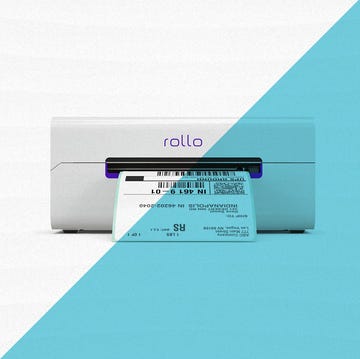The metaphorical light bulb above Tim Leatherman's head clicked on while he was touring Eastern Europe on the cheap in 1975. Desperate for a way to turn a stripped radiator handle in his freezing hotel room, the 27-year-old, unemployed, newly married mechanical engineer looked long and hard at the overmatched Boy Scout–issue knife in his hand.
"Wouldn't it be something if I could add a pair of pliers to a pocketknife?" he asked himself. Fast-forward 35 years and 40 million multitools sold, and today Tim Leatherman embodies the dream of financial and creative freedom that motivates independent inventors everywhere. The Portland, Ore.–based company bearing Leatherman's name employs 500 people and dominates a $200 million worldwide market for pocket tools that he pioneered.
The tool was hardly an overnight sensation. Years of experimentation, false starts, dead ends, rejection and frustration marked Leatherman's course. Looking back, he claims he wasn't even an especially visionary inventor and, at the outset, knew "nothing about business, sales or finance." Not that it stopped him.
Passionate, persistent inventors like Leatherman, set on seeing their creations take wing, have been a driving force in the American economy since our nation's founding. Our country's penchant for innovation is partly the result of U.S. patent law, which was designed to encourage and protect inventors. But it also reflects a national character inclined toward problem-solving and risk-taking.
For much of the 220 years since George Washington signed off on the first patent, individual inventors, not to be confused with their corporate and institutional brethren, have been the engine of American industry—mavericks like Edison, Bell and Carrier. Their breakthroughs banished darkness, projected human voices across hundreds of miles and cooled the sizzling Sun Belt. Trace back the roots of many blue-chip companies, and you are sure to find a solitary inventor who once had a transformative idea.
The drive to invent is more powerful than ever, but the road isn't always easy for independent inventors. Out of the 77,501 U.S. utility patents granted in 2008, just 6 percent went to individuals. Only a third of applications at the U.S. Patent and Trademark Office (USPTO) even earn a patent, and among patents granted, the number that become commercially viable ranges from an estimated 5 percent to as low as 0.2 percent. That's a lot of wreckage left by the side of the road.
Who wins and who loses at the high-stakes game of invention can seem arbitrary. And yet our economy is studded with examples of innovators who, like Leatherman, have launched one successful product after another into an unforgiving marketplace. We consulted with a number of professional inventors to distill the secrets of the craft. Some have made careers out of invention, others have founded industries. Their consensus: No shortcut exists to success, and nothing substitutes for grit and determination. So, if you're sitting on an idea that might be the next great American invention, here's your playbook.
1. Cultivate an Idea
The annals of invention are studded with one-hit wonders, inventors whose single blockbuster idea made them a fortune. But the most prolific inventors can't turn off the idea machine. They are too restless and creative. Inventors simply see life's many obstacles differently than the average person, according to medical-devices inventor Robert Fischell. "The key to inventing is the awareness that a problem is the trigger from which an invention can be created," says Fischell, who holds more than 200 patents for innovations such as an implantable cardiac defibrillator and improved stents. "When I'm in the operating room and a surgeon throws a tool against the wall in frustration, I say, 'Great, here's an opportunity.'"
Fischell, who at the height of his career filed a new patent application every six weeks, wastes no time in determining whether his latest idea meets the patent test of being new, useful and nonobvious. He goes right to the U.S. Patent and Trademark Office's database of issued patents (patft.uspto.gov) and performs a search. "If you read a patent and someone has already solved the problem, then you're still an inventor. You just got there late," he says.
If, after a preliminary search, your idea proves novel, then continue developing it. But be realistic about what you're getting into. "The time you devote will be double what you think it will be, and the dollar amounts you commit will be four times what you thought," Leatherman says.
Make rough sketches, perform tests, flesh out concepts and keep detailed notes. Patent attorneys advise their clients to maintain a log in a permanently bound notebook that gets stamped by a notary public on a frequent basis. A logbook becomes important in cases before the U.S. Patent and Trademark Office involving identical innovations, as the burden of proof falls to patent applicants to demonstrate that they were the first to conceive of an invention.
At this early stage in the game, your investment of personal time and money will have been slight compared with what is around the bend. Before proceeding, you'll have to ask some hard questions about both your idea and yourself: Is my idea significantly different than any that precede it? Is there a sizable market for the product? Can it be developed and manufactured at reasonable cost? Who is the customer, and why should they buy my product and not a competitor's? And finally, am I willing to commit myself fully to making this idea succeed?
Inventors who have been through the process caution not to underestimate the emotional and psychological fortitude required. "Can the invention fail and not the person?" asks Dean Kamen, inventor of numerous medical devices, the Segway and the iBOT all-terrain wheelchair. "If you can't afford emotionally and intellectually to fail, if your ego would be wiped out, then don't do it."
2. Build a Prototype
With the availability of powerful computing and computer-assisted design software like Autodesk Inventor and SolidWorks 3D CAD, inventors today live in what Kamen refers to as "the ultimate candy store." The earliest versions of Kamen's first invention, a wearable infusion pump that delivers precise doses of medications such as insulin, sprang to life not on a computer screen but in a workshop set up in the basement of his parents' home on Long Island, N.Y. Kamen was a teenager at the time.
Even when designed in a highly precise digital CAD environment, a product eventually has to make the leap to the real world in the form of a prototype. For a sizable fee, specialty prototype firms translate drawings into molded plastic or steel. Or you might try your luck with a local machine shop. Depending on the materials involved and the complexity of an invention, the cost of making a quality prototype can empty a bank account and force an inventor to seek funding at a very early stage.
Tim Leatherman advocates taking a DIY approach. During a trial-and-error phase lasting three years, he built prototypes of his groundbreaking multitool from cardboard, wood and metal until he settled on an advanced design. "By working with my hands," he says, "I learned about obstacles to functionality and manufacturability."
Once you have your prototype, it's time to troubleshoot your invention. Get outside your own head and go to experts in the field, Fischell recommends. "Ask them, 'Do you think my idea has commercial merit? Would you use it?' But make them sign a confidentiality agreement," he says. For inventors, the prospect of intellectual property theft is very real, but too much caution can become immobilizing. A confidentiality, or nondisclosure, agreement allows you to field-test in confidence.
Feedback from Mario Salazar's target audience—carpenters—compelled the Colorado Springs inventor to fine-tune his digital miter gauge. The mechanical prototype he built in the basement with a soldering iron, an oscilloscope and a milling machine picked up on eBay worked smoothly and felt right to Salazar, but the tradesmen wanted it bigger and more affordable. "You can't fall in love with your invention," he says. "Get feedback and make alterations accordingly."
In the rough-and-tumble business world, a patent protects the inventor by granting the exclusive right to exclude others from making, using or selling his invention for a 20-year period. That's the theory. In practice, a patent gives the inventor a head start against the wolf pack. "When other people see you making money, your patent will be the only means you have for maintaining control of the market," says Lonnie Johnson, founder of Johnson ElectroMechanical Systems and inventor of the Super Soaker water gun.
3. File a Patent
Patent law is complicated stuff, so get an experienced patent attorney to write and file your patent application. Expect to pay between $3000 and $10,000. "Hire a patent attorney who also has a degree in the field you're applying for a patent in and who knows your market," Salazar advises.
A skilled lawyer can draft a broad patent that protects an invention against infringement from any angle. In the case of Richard Phillips, owner of International Survival, his well-crafted patent application made it impossible for anyone to copy the thin, shock-absorbing material he developed for his protective paintball vest. "My lawyer spread the patent out so far above and below my laminated foam material's properties that a competitor's vest would have to be so heavy the wearer couldn't walk or so light that the vest falls apart when hit," Phillips says.
On average, patent approval takes three years and may require going back and forth several times with patent examiners. From the moment a patent application arrives at the USPTO until it is either issued or abandoned, an invention is covered by patent-pending status. In the case of John Marsden, who invented Pour 'N Store, a bartending system of plastic bottles and pour spouts for drink mixers, a pending patent amounted to a suit of paper armor. "One company said, 'If you don't sell us the patent we're going to compete with you.' I didn't have enough money to fight them in court. We eventually made a deal, and they paid me royalties for years."
According to Salazar, any inventor has to be ready to do battle. Having a good lawyer in your corner is a must. "If your idea's good, then someone is going to steal it. If no one's trying to steal it, then the idea's probably no good," he says. "I'll have my lawyer send a cease-and-desist letter if someone infringes on my patent. If it continues, I give them the diplomatic option to buy a license from me. If diplomacy doesn't work, then that's when the money goes out the door in legal fees. And in the end, a patent is only as good as the thickness of your wallet."
4. Test the Market
Once the patent application is complete, the inventor must switch from building an idea to building a business. Rare is the creative genius behind an invention who also has the business chops—or the interest—to oversee the manufacture, marketing and selling of his creation. So even the brightest creative minds can fall victim to the numerous scams and questionable invention-promotion firms whose ads litter the Internet. Most professional inventors urge caution with any outfit that asks for money up front to shop your ideas around.
A safer route when you're in the thickets is to find a partner whose skill set complements yours. Mario Salazar, a born salesman, teamed with Jay Burgan, who has an engineering and software background. Tim Leatherman accrued crucial know-how in business and manufacturing by joining with Steve Berliner. It didn't hurt that Berliner's dad owned a metalworking business. John Marsden, the Pour 'N Store developer, partnered early on with business school graduate Ed Harrigan. "If I hadn't had Ed, I probably wouldn't have made it," he says.
With a solid business team set up, the next step is market research and test marketing. Marketing studies—perform your own or commission a market research firm—will give you data about market trends and customer demographics. There is no substitute, however, for putting your invention in front of potential customers as well as manufacturers, suppliers and distributors to get a sense of its market value. For the inventor, this is an anxious time. As Robert Fischell learned, thick skin helps. "For many of the inventions I've done, somebody always said, 'It'll never work.' I went to a famous doctor at a major medical center with one of my early stent designs. He told me there's no future in stents. Well, that's a $6 billion market now."
Salazar is a big believer in showing your wares at trade shows. "You'll find out who is doing what, whether you'll be able to compete and if someone is willing to buy what you have," he says. "But you're also dropping your drawers and everyone will see what you've got. Your product had better be 95 percent complete. Be ready to answer questions: How big is the market? Who's going to buy it?"
5. Sell It or Make It
Inventors make money in two ways: collecting royalties by licensing the right to manufacture their invention or manufacturing, distributing and marketing the invention themselves. Sooner or later, all successful inventors reach this fork in the road and must decide for themselves which route to pursue. Louis J. Foreman, founder and chief executive of Enventys, a product design and engineering firm in Charlotte, N.C., and author of The Independent Inventor's Handbook, has personally faced that dilemma multiple times as the holder of 10 patents and has advised numerous inventors as lead judge on the PBS program Everyday Edisons. "The first thing to do is build a pro forma income statement. Figure out what kind of revenue you could generate versus the overhead and expenses selling that product," Foreman says.
Then it's time to ask yourself another round of questions: First, is there enough upside potential to merit the risk of bringing the product to market yourself? "Factor in opportunity costs too," Foreman says. "If you have to give up a job that pays $100,000, can you make enough to offset that?" Second, do you have the financial resources to pull it off? If you don't, then where is the money going to come from? And finally, do you have the competence to run a business? "It's one thing to come up with an amazing product, but are you comfortable selling it, can you distribute it, replenish it and fulfill orders if Walmart gives you a 5-million-piece purchase order?" Foreman says.
There is no doubt that licensing is the easier route to getting an invention to market. It requires less devotion of time and up-front capital and frees inventors to do what they do best: invent. But expedience comes at a cost. Royalty rates on patents—formulated on list price, production run and other factors—average less than 2 to 7 percent of retail sales. Still, for a first-time inventor short on funds and know-how, a licensing agreement can be the pot of gold at the end of the rainbow.
Lonnie Johnson, who fashioned his Super Soaker prototypes using a Unimat hobby lathe and milling machine while moonlighting from his job at NASA's Jet Propulsion Laboratory, intended to manufacture his invention. Bids he received from injection molding companies quickly killed that idea. "When I learned it would cost $200,000 to make 1000 guns, I decided to license," he says. "I didn't have that kind of money." Today he does. Retail sales of the Super Soaker have exceeded $1 billion, and royalties have made Johnson a wealthy man.
Manufacturing a product, on the other hand, is a leap into the unknown. To get started, you need to find investors for financing, then build relationships with potential manufacturers and distributors. Then there's marketing, sales and management. It can be as much if not more work than you put into the development of the invention itself. But the potential profits are far higher than any license.
Tim Leatherman was an accidental industrialist. His first inclination after perfecting a functional prototype of his multitool was to shop it among knife companies with a licensing arrangement in mind. "When knife companies took a look at the prototype, they said, 'That's not a knife. That's a tool.' So then I went to tool companies, and they said, 'That's not a tool. That's a gadget.'"
Leatherman began to get discouraged, and took a job as an outside salesman for a welding products company. He worked there for four years before Berliner, a friend from college, stepped in and said, "We need to start our own company."
Rejections continued to pile up. They started shopping the invention around to mail-order catalogs, but got no yeses. Finally, they took it to a mail-order company out of Seattle. "And instead of just kicking us out the door," says Leatherman, "they sat us down and said: 'How can we make this less expensive?'" He and Berliner went back to the drawing board, simplifying the prototype in an effort to lower the manufacturing cost from $40 per unit to $24. Then they resolicited the catalog companies with their pared-down tool.
"Later we got a letter from Cabela's," Leatherman says. "Inside was a purchase order for $12,000 for 500 tools. You can't believe how happy I was."













